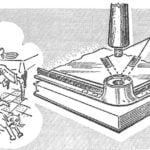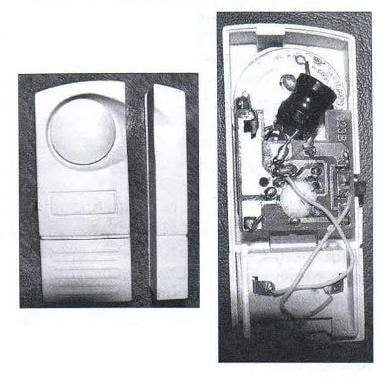Sound transducer – piezoelectric capsule SN-22 may be replaced by another with similar characteristics. Feature of the pulse generator is that they are compatible with the resonant frequency of the cap HA1 and emit the signal of one tone, and “iridescent”, which attracts attention with its sharp,
loud and, I would say unusually nasty sound.
In addition, a sound capsule in the housing is covered by a flap that provides even greater resonance and amplifies the sound volume.
This device, along with the undoubted “advantages,” has a couple of drawbacks.
The autonomy of the power supply (although in some circumstances this is a positive quality: elements of power-enough for many months given 1…3 short-term positives in the day). This drawback is easily eliminated by connecting a stationary source of DC voltage 3…5 with a large ratio of stabilizing and filtering voltage. Un to increase above 5 In should not be – you can disable the generator device. Descriptions of schemes such power sources (adapters) with these characteristics in Amateur radio literature lot now, so here to bring it will not. The current consumption from the power source with a voltage of 5 V In alarm mode – 55 mA, and a quiescent not recorded at all (due to their smallness). The main thing is a good stabilizing and filtering voltage oxide capacitors on the power supply output with a high (at least 3300 UF) capacity. When there is insufficient filtering of the source of fixed voltage buzzer alarm will give the network the “background” frequency of 50 Hz and a characteristic noise in the form of hoarseness and groans. When connecting a stationary source of power, of course, you lose the portability of the device and its autonomy (it is bad if the voltage of 220 V is shut off), but this time depends on the plans of Amateur radio usage of the structure.

Node sound alarm with sound pressure 95 dB
Schematic diagram of the device with an additional node (indicated by the dotted line)
The ability to disable the audible alarm (the device has a regular switch SA1) can also be considered both a plus and minus of the design – it all depends on its specific application. For example, in the author’s version of a node ensures the protection of the safe with civilian and hunting weapons. Therefore, for critical cases (as well as with the security of the apartments), you must enter the node locking, which once engaged, will signal to sound until the node is powered up. And to provide covert alarm switch is also easy and anyone can do it. The changes relate to the introduction into the scheme of the thyristor VS1 (as shown in the diagram by a dotted line), the gap of the conductor marked “X” and short circuit of contacts of the power switch SA1.
Now, when disconnecting the two-piece design, installed, for example, on the doors of the safe, positive potential will go to the control electrode of the thyristor VS1, open it, and because of this, the supply voltage will be filed to the node generator.
The alarm will be activated as long as the power is turned off (at least briefly).
Power sound pressure of the device is large enough that the signal can be heard well during the day (and especially night) with different force on all floors of the stairwell of an apartment building (in case of unauthorized opening of the door of the safe house).
A. KASHKAROV, G. s a n t-P etersburg
Recommend to read
 ARMOR SUCCUMB TO “STORM”
ARMOR SUCCUMB TO “STORM”
The first domestic anti-tank missile system (ATGM) was "bumblebee", developed in Kolomna SKB engineering under the guidance of S. P. Invincible. However, quite a large mass and a decent... WILL FOIL
WILL FOIL
Modern kitchen stool with screwed-on legs all good, except one: for some reason, no-no one of the legs starts to spontaneously otsenivaetsya. The simple tip will help to fix reliably a...


